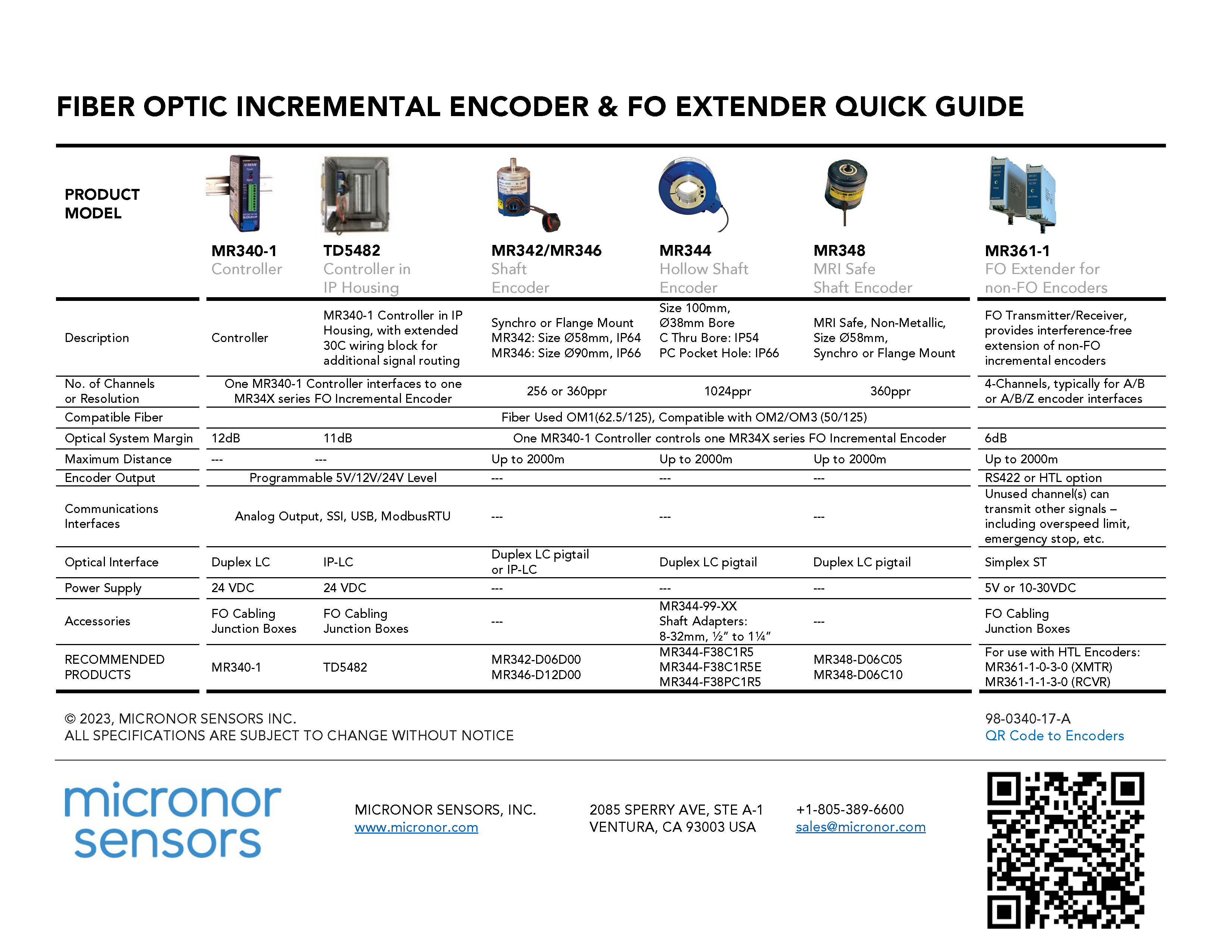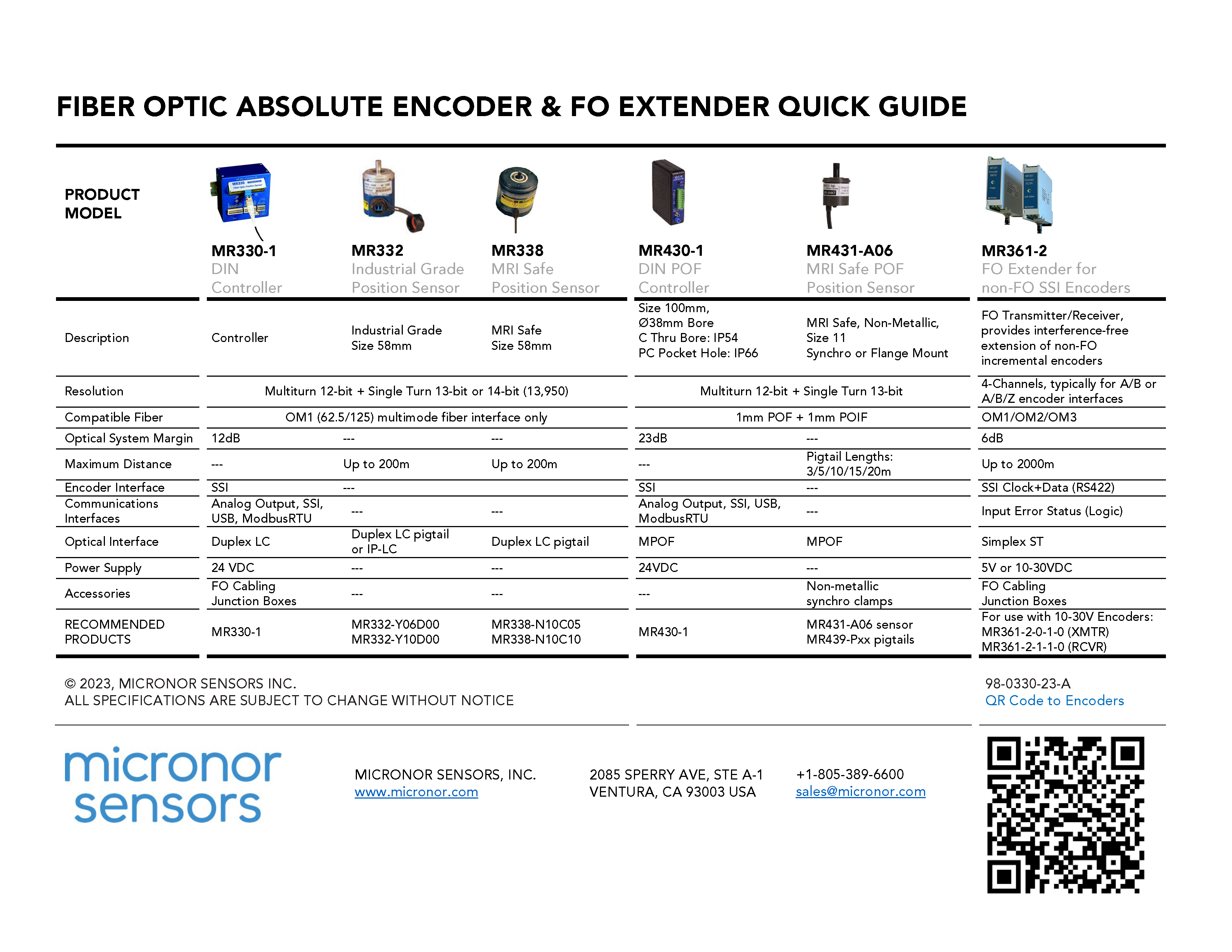First, what type of encoder does your application require?
- Absolute encoders (also called position sensors) are used where monitoring absolute position and high precision are required. Their signature output is a digital value of absolute position. Even if an absolute encoder loses power, the system will always report it current true position upon start-up.
- Incremental encoders are used where speed and relative position need to be monitored, and typically offer lesser resolution than an absolute encoder system. Their signature outputs are A/B quadrature pulses. The user’s motion control system tracks these pulses (phasing determines direction) to monitor relative position from initial Home setting. The same system measures the time between pulses to track speed. If the system loses power, all position and speed information is typically lost.
MR340 Series FO Incremental Encoders and MR361-1 Series FO Extenders
Fiber Optic Incremental Encoders and FO Extender System for non-FO Incremental Encoders
MR340 series is Micronor’s 3rd Generation Fiber Optical Incremental Encoders – comprising both rotary and linear models. Fiber optic incremental encoders are typically used to sense the motion and speed of a motor shaft or linear actuator where conventional electronics-based encoders and resolvers are inadequate. Typically the user’s control system is looking for A/B quadrature signals for which electro-magnetic interference and noise causes system errors.
Micronor Fiber Optic Incremental Encoders are based on an all-optical passive sensor design which optically connects to a remote controller via a standard duplex OM1 62.5/125 multimode fiber optic link spanning distances up to 2000 meters. The Controllers offer much more interface capability besides A/B quadrature outputs. The additional built-in analog (4-20mA, ±10V) and digital interfaces (RS485, USB, Modbus RTU) can also be user-programmed to output speed or position status.
MR361-1 series Fiber Optic Extender for Incremental Encoders allows conventional electronics-based incremental encoders of all manufacturers (electronics based, optical or magnetic, such as Micronor ESI/ENI series) to reach longer distances by converting the encoder’s A/B/Z quadrature signals to optical signals which can then be transmitted interference-free up to 2000 meters to the remote motor drive or other motion control system. The passive nature and inherent safety of fiber optics provides a safe means of routing sensitive encoder signals through noisy electrical areas or hazardous locations. The MR361-1 system operates with complete transparency to the motion control or motor drive system.
The system consists of a fiber optic transmitter (XMTR) and fiber optic receiver (RCVR) module. The XMTR module multiplexes the quadrature output signals of the user’s encoder into a light signal. A simplex multimode fiber optic link transports the optical signal to the RCVR module which then demultiplexes the optical signal back into the individual electrical quadrature signals for connection to the encoder input of the User’s drive or motion system.
MR330 & MR430 Series Absolute Encoders and MR361-2 FO Extenders
Fiber Optic Absolute Encoders and FO Extender System for SSI Absolute Encoders
The MR330 and MR430 series Fiber Optic Position Sensors (aka Absolute Encoders) measures absolute angular position from 0° to 360° and can track up to 4096 turns.
The MR330 series uses 62.5/125 Glass Optical Fiber (GOF) and provides 13/14 bit (0.026°) single-turn resolution and 12-bit multiturn tracking. The system can operate at full accuracy at speeds > 2500 rpm and distances > 300 meters. This sensor system uses a novel optical spectral imprint technique. The sensors is available in both Industrial and MRI Safe models. The DIN Controller provides multiple built-in interfaces: SSI, USB, RS485/Modbus RTU, Digital Set Points and Analog Outputs.
The MR430 series is based on Plastic Optical Fiber (POF) technology that achieves a new sweet spot for size, cost, and performance, for the many challenging applications and potential designs that could not formerly justify using fiber optic sensor technology. In size, the MR430 sensor features a miniature Size 11 (Ø1.1”) form factor suitable for the smallest robotic or actuator mechanism. In performance, the encoder offers 25-bit resolution (13-bit Single Turn + 12-bit Multi-turn) with an update rate of 850µs and ability to operate interference-free over distances up to 30 meters (100 ft). In cost, the use of inexpensive POF cabling optics achieves a price point less than prior glass fiber-based absolute encoders. The sensor’s non-metallic construction offers both magnetic immunity and transparency for MRI applications as well as superior corrosion resistance for the harshest industrial environment.
MR361-2 series SSI Fiber Optic Encoder Extender allows conventional electronics-based absolute encoders of all manufacturers (electronics based, optical or magnetic, such as Micronor ESA/ESAM/ENA/ENAM series to reach longer distances by converting the encoder’s SSI position protocol to optical signals which can then be transmitted interference-free up to 2000 meters to the remote motor drive or other motion control system. The passive nature and inherent safety of fiber optics provides a safe means of routing sensitive encoder signals through noisy electrical areas or hazardous locations. The MR361-2 system operates with complete transparency to the motion control or motor drive system with an SSI interface.




